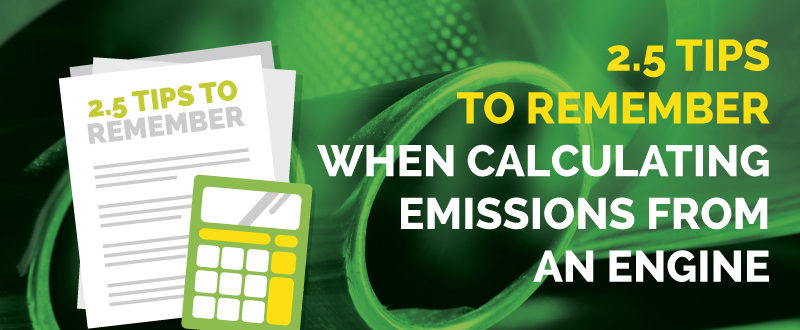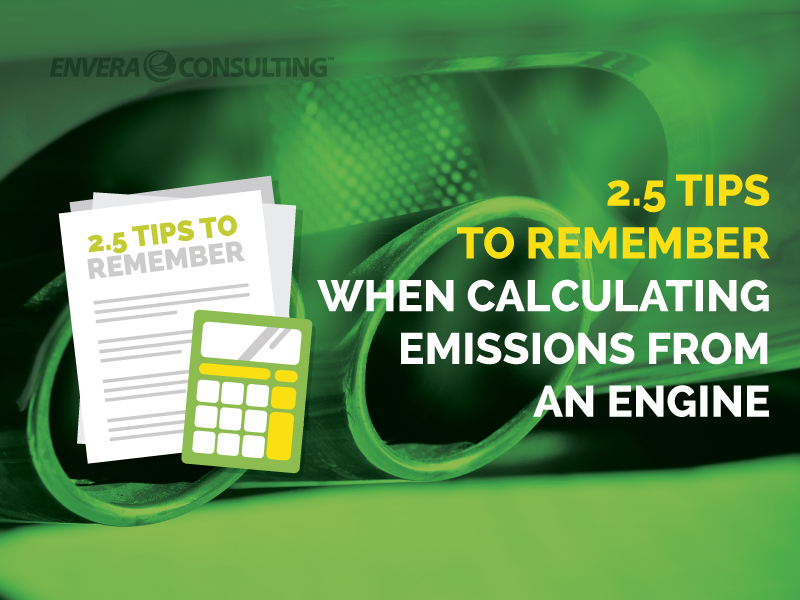

Anyone who’s sat through high school physics or college calculus has heard the phrase “plug-and-chug.”
“Plug-and-chug,” explains Gerd Kortemeyer, an associate professor at Michigan State University, means “plug[ging] numbers into formulas without considering the physical meaning of the equations, then frequently [taking] the result and [plugging] it into the next formula.”
In previous newsletters, I’ve written about the general formula for estimating air emissions from almost any piece of equipment:
E = A x EF x (1 – control)
While at face value, the formula implies a plug-and-chug type of exercise, there are a few problems when applying this method to calculating emissions from engines, so I’ve come up with the 2.5 tips to help you along.
1. EPA Method 19 Is Your Friend
Depending on what the engine emissions will be used for, there are cases, particularly when accuracy is a key factor, where using actual data is preferred over default emission factors.
In most cases, “actual data” is derived either from a stack (source) test or data from a continuous emissions monitoring system (CEMS). And while these sources of actual data are more accurate, they come with their own set of problems.
For one, actual data is typically expressed in the form of an emission concentration (e.g., parts per million), which is quite different than a “plug-and-chuggable” type of emission factor, which expresses the amount of of emission in terms of volume or time. In other words, in order to get a usable number, it’s back to the conversion methods you learned in high school physics. In this case, the conversion method is known as EPA Method 19.
By using Equation 19.1 and the conversion factors in Table 19.1 (both found in EPA Method 19), you can convert an emission concentration into an emission factor. Taking this one step further, if you wanted mass per fuel consumed on a volume basis, you would then need to multiply by the higher heating value of the fuel (assumed to be 1,050 MMBTU/MMSCF for natural gas).
Method 19 takes some getting used to, but once you do, it’ll help you get one step closer to being able to plug and chug your emission calculations.
2. Data Won’t Come in a Nice, Neat Package
You can’t plug and chug if your data isn’t in the right form. And, more often than not, you’ll have to do some extra work to get it there.
One reason is that gathering the data needed to calculate emissions from an engine typically requires you to ask someone else for different parts of the information. This can be challenging. For example, you may be looking for the volume of fuel consumed, but the engine operator may only have records of the elapsed time because the engine has a timer and no fuel meter. Or an operator may tell you that the only available records state that five gallons of diesel were used in July, giving you an incomplete overview of the year’s consumption. In both of these examples, you may need to start with the data on hand and extrapolate to the value you need.
Because field data will come in different units and time frames and will be associated with different parameters, your job is to know how to convert the data so it’s usable in your equation. Conversion methods vary greatly, and a full explanation would take too long to explain here, so contact us if you need help with data conversions.
2.5 Sometimes More Data Is Needed
This point is somewhat related to #2 but is important enough that it deserves its own (half) section. Going off what we just discussed, you may also need to research additional information. For example, depending on the type of emission factor, you may need to know the size of the engine. Three of the most common types of emission factors for engines include:
- Mass per fuel volume (ex: 469 lbs NOx (nitrogen oxide)/1,000 gallons of diesel combusted)
- Brake-specific emission factor (ex: 0.25 g NOx/bhp-hr)
- Mass per time (ex:10 lbs NOx/hr)
In the case of a brake-specific emission factor, you also need the engine rating (e.g., 525 brake horsepower, or bhp) in order to complete the equation. You can usually find the engine rating either on the equipment’s air permit or in the manufacturer’s documentation.
Another example of when additional data is needed is when emission factors combine pollutants together, such as with volatile organic compounds (also referred to as non-methane hydrocarbons, or NMHC) and NOx. Sometimes engine manufacturers provide engine-specific emission factors in terms of NOx + NMHC (e.g., 1.5 g NOx + NMHC/bhp-hr). This can be problematic because, in most cases, you need to report the emissions of NOx and organics separately, which means you need to determine the separate distributions of each.
The overall takeaway is that, before you can plug-and-chug, you need to be prepared for the possibility that you’ll need to supplement your existing data set.
If you need help sifting thorough all of the data needed to calculate emissions from an engine, contact us and we’ll be happy to help.